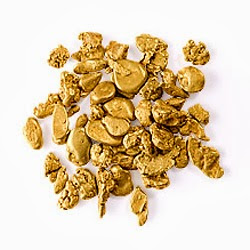Monday, October 19 2020
Are you excited about finding gold — ANY size gold? Most of us are, but if you want to sound like an old pro when referring to a Flour Gold: Gold particles that are barely visible to the naked eye. It’s so powdery, like flour, that it sometimes floats instead of sinks like heavier gold pieces. Flake Gold: A piece of gold that is large enough to easily spot, but is difficult to pick up with your fingers. Use tweezers. Fines: Particles of gold too small to pick up with your fingers. Combination of flake and flour gold. Picker: A piece of visible gold large enough to easily pick up with your fingers. Gold Nugget: Larger than a picker. A naturally formed lump of gold that is big enough to put in a poke and likely won't fit in a typical small vial, depending on its shape. Specimen: A naturally formed large gold nugget or gold-laced quartz specimen. Paydirt: Refers to dirt that has enough gold in it to be worth extracting. The term originated in the mid-1800 during the California Gold Rush. Today, you can even buy Alaska paydirt through the US Mail! Concentrates: All the gold-bearing material left in your sluice or trommel, etc. after using your gold recovery equipment - usually black sand mixed with fine gold. Fool’s Gold: The bane of any prospector’s existence! Iron or copper pyrites and mica can be mistaken for gold. The quickest and simplest test is to examine your sample in the shade, not in the sunlight. Real gold retains its yellow sheen even in shadow, whereas fool's gold does not. Real gold is soft and malleable; it can be cut with a knife and won't splinter. You can even "dent" it with a pin. Fool's gold, though, is hard and flaky. A drop of hydrochloric (muriatic) acid will tell you for sure. Real gold will not be affected, but if you see a slight foaming action and the sample begins to dissolve, you know it's not real gold. Color: Slang for any amount or size of visible gold that you find in your gold pan. Au: Gold is element 79 and its symbol is Au on the periodic table. As a pure metal, gold is extremely heavy with a specific gravity of 19.3, which means pure gold weighs 19 times more than an equal amount of water.
|
|
Nugget of News Blog |






